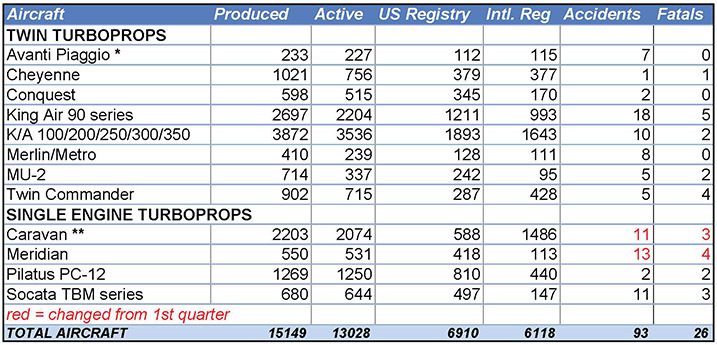By Dale Barnard

What do Donald Sutherland, Charles Bronson, and Jim Brown have in common with Twin Commander and turboprop fleets? A lot. In the movie, a dozen misfit prisoners were given a dangerous assignment behind enemy lines to eliminate the German High Command that was planning the D-Day defenses. If their mission succeeds and they return alive, they will earn a reprieve from their incarceration. So goes the fate of our dozen turboprops. Depending upon their respective safety records, stable fleet populations and ongoing service and support from OEMs and suppliers, they may or may not live to fight the battle the next day.
We continue to track the top eight twin-turboprop and top four single-engine turboprops representing the bulk of general aviation’s mainstream turboprops. The analysis includes aircraft in and out of production, their respective U.S. and international fleets, and U.S. NTSB-reported incidents for each aircraft model from January 2010 thru June 30, 2014. Because we are seeing active fleet migrations both to and from the United States depending upon the model, we have begun tracking overall fleet movements between the United States and the international markets for singles and twins to gain a better perspective moving forward.
Twin Turboprops
Twin Commanders lost one airframe in the second quarter due to deregistration. The U.S. registry of Twin Commanders shrank by four airframes while the international registry gained three airframes. This overseas fleet migration shows no signs of abatement, with a net deregistration of five airframes since the first quarter of 2013. The aircraft remains fully supported by the factory and the worldwide authorized service centers. Ever-vigilant operators continue to make strategic investments in their fleets to include avionics and powerplant upgrades.
Current Piaggio Avanti production is unclear. The newly redesigned and branded EVO has been well received by the European media and prospective fleet owners. The EVO is an improvement in almost every way including top speed, time to climb, fuel burn, range, and noise abatement. Only time will tell if demand for the EVO will create adequate sustained production.
The Beechcraft (Cessna) King Air is in its 51st year of production, with more than 6569 airframes built through the second quarter of 2014. The King Air family remains the only twin turboprop in this class in continuous production. As we’ve discussed, King Airs are fully supported throughout the United States and the world, making the venerable twin a favorite among commercial operators. In fact, this twin is so popular it not only has produced more aircraft than the other six twin turboprops combined, it now represents 77 percent of the worldwide fleet in this class.
The King Air 90 through 350 series added another 22 airframes during the second quarter, with domestic deliveries outpacing international by a five-to-one margin, a complete reversal from the previous quarter.
Piper Cheyenne registrations remained unchanged between the first and second quarter of this year. Interestingly, there were no NTSB incidents or accidents for the type in the first half of 2014. The aircraft remains popular in certain commercial aviation segments, including air ambulance and cargo operations. The active fleet is split evenly between the U.S. and international markets.
Fleet numbers for the Mitsubishi MU2 remained steady from the first quarter’s worldwide count of 337 active airframes. The OEM continues to support authorized service centers and dedicated operators alike. However, with only 337 airframes remaining, sustainability and parts/service support concerns are on the horizon.
Single Engine Turboprops
Cessna Caravan production of 29 new airframes in the second quarter led all turboprop models. International deliveries outpaced U.S. deliveries by an 8-to-1 ratio and, overall, international Caravan deliveries continued to outpace all remaining international single-engine turboprop deliveries. Caravans were involved in two NTSB events including one fatal accident in the second quarter, a decline from nine incidents including two fatal accidents in the first quarter.
Piper Meridian production again increased by eight airframes. The NTSB reported that five Meridian accidents occurred during the first half of 2014, including a fatality in June.
In an accelerating trend, Pilatus PC-12 domestic deliveries outpaced international deliveries 20 to 1. Fully 65 percent of the active fleet is registered in the United States. The PC-12 continues to be accident-free so far this year, according to the NTSB.
Daher-Socata manufactured one TBM Elite 900 airframe in the second quarter, bringing the total TBM fleet count to 680 produced, 74 of which represent the “Elite” model. The majority of this fleet’s active airframes –– 77 percent –– maintains U.S. registry.
The last nine months have not been especially kind to single- or twin- engine turboprops. We continue to lose legacy and in-production airframes. If it continues unabated, this steady string of losses will continue to have a negative effect upon the fleets in terms of insurance, financing, and marketability. To their credit, all 12 turboprop types continue to enjoy a dedicated following committed to maintaining sustainability.
Overall, the U.S. turboprop registry remains at 53 percent of the total fleet. In the twin market, 54 percent of the active fleet remains U.S. registered while only 51 percent of the single-turboprop fleet is U.S. registered –– down another point from the last quarter.
Six of the 12 airframe types we track are out of production. Combine this with a steady stream of losses from both in- and out-of-production aircraft and you start to appreciate the concerns that aircraft finance, insurance, and service center providers have about eroding fleets. Thus, just like Lee Marvin’s dozen misfits, these turboprops face a challenge to survive and prosper over the long terms in an already tough market.
Fortunately, we have met the enemy and, for most part, it is ourselves –– and therefore correctable. Stay tuned for our third-quarter report to see if we are making a proper “course correction.”
You may come to different conclusions about these numbers. Feel free to contact me at 360-635-8008 or [email protected] for vigorous debate, questions, or comments. Until then, fly safe, Commanders!
